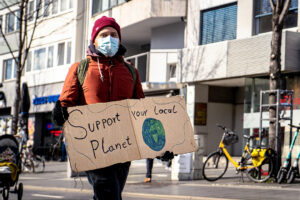DELEGATES at the United Nations COP27 climate conference this month have been seeking to understand why the world is failing to raise the cash needed for emerging countries to prepare for climate change. The answers are visible all around them.
Egypt — home to Sharm el-Sheikh, the resort town hosting the event — last month devalued its currency, bringing the pound’s decline this year to nearly 36%. Bailout programs with the International Monetary Fund and Gulf monarchies over the past decade have amounted to nearly $130 billion, equivalent to a third of national income. Forget wind farms and desalination plants. Egypt barely has enough cash to pay for its wheat imports.
For all that the politics and technology for tackling climate change has improved in recent years, the financial picture has been deteriorating. Rising interest rates are particularly punishing for renewables, whose costs are all in the construction stage and must be debt-financed years into the future. Cutting borrowing costs by 2% in emerging markets would save $15 trillion from the cost of hitting net zero, the International Energy Agency wrote last month — but the movement right now is in the opposite direction.
The surging prices of food and fossil fuels make things worse for the large number of emerging economies that aren’t self-sufficient in those commodities, raising their import bills and draining exchange reserves before they even think about major overseas investments. A greenback still hovering at record levels makes things even worse, pushing dollar-financed renewables projects toward default.
“The macro environment is creating concerns among our investors,” said Mikkel Torud, chief financial officer of Scatec ASA, a Norwegian company that invests in renewables projects including Egypt’s 1.8-gigawatt Benban solar park. “Our cost of capital is going up and we are seeing these types of project demanding higher risk premiums.”
There are well-established ways of managing this. Having multiple projects in different countries reduces a developer’s exposure to individual governments. Partnering with multilateral institutions such as the World Bank also allows state or quasi-state lenders to take on the worst political and currency risks, creating a more attractive environment for private investors.
Clearly, though, it’s not enough. A 13-year-old target of providing $100 billion in annual climate finance to developing countries has still not been met. The funding that’s there, moreover, is overwhelmingly dependent on states. An ideal situation would be one in which every $20 of high-risk, low-return state and multilateral funding was able to mobilize another $80 of private investment. In practice, the ratio is pretty much the opposite, with $66 billion in public climate finance in 2019 needed to put $14.4 billion of private money into action.
Furthermore, even a fully-functioning international finance mechanism is unlikely to deliver poorer countries what they need. Facilities like the Benban solar park — renewable and low-carbon industrial and power projects that reduce present-day emissions, known in the climate jargon as “mitigation” — are the most investable ones, and in less developed nations other projects may be worthwhile.
That’s because, outside of the BRIC nations and a handful of other emerging industrial powers such as Indonesia, Mexico, South Africa, and Turkey, mitigation isn’t the most critical battle to fight. Less wealthy countries don’t account for many emissions. Excepting South Africa, the whole of Africa south of the Sahara produces about the same amount of carbon pollution as France. The far greater priority in such places is investment known in the jargon as “adaptation” — sea walls, storm protection, and drought-resistant crop technologies to deal with the effects of climate change, rather than stop its cause.
If the challenges of bringing mitigation money into lower-income nations are substantial, funding adaptation is well-nigh insurmountable. Such projects are rarely investable even in wealthy countries with sophisticated financial and regulatory setups — one reason that most infrastructure spending is done by governments or at least public-private partnerships. In poorer countries, there’s almost no chance.
“The most significant climate adaptation investments like sea level and flood defenses do not provide a substantial revenue stream for the private sector,” Avinash Persaud, a Barbadian economist who’s advised the country’s Prime Minister Mia Mottley on financial approaches to climate, wrote in August.
Beyond even adaptation, loss and damage — straight compensation for the financial cost of floods, cyclones and heatwaves in countries without the fiscal capacity to pay for it themselves — is only likely to be funded by governments, rather than private companies.
Persaud has suggested using the IMF’s unofficial currency of Special Drawing Rights to take more risk and attract more private money, as well as a levy on emissions similar to the small fee on oil imports that funds the International Oil Pollution Compensation Fund, a long-standing institution to pay cleanup costs after tanker spills.
Multilateral lenders could certainly up their game. The World Bank only stopped financing upstream oil and gas in 2019, and its current President David Malpass has equivocated on issues as basic as whether fossil fuels are warming the atmosphere.
A better lesson may be to learn from the oil-and-gas industry. Petroleum is a rare business that flourishes in frontier markets where many investors fear to tread. Its secret is that most of its product is sold in the same markets where finance is raised. If your financing and revenues are both in dollars, a currency crisis doesn’t cause your project to default — indeed, it may even make it more competitive as local-currency costs decline.
That’s reason to pay attention to more speculative investments in green hydrogen and building a robust system of climate offsets for protection and expansion of tropical forests. In technological terms, they seem less attractive than more tried-and-tested wind and solar power generation for local grids. In financial terms, though, such export industries may have crucial advantages — and the turmoil of 2022 may be just the moment to test their mettle.
BLOOMBERG OPINION
